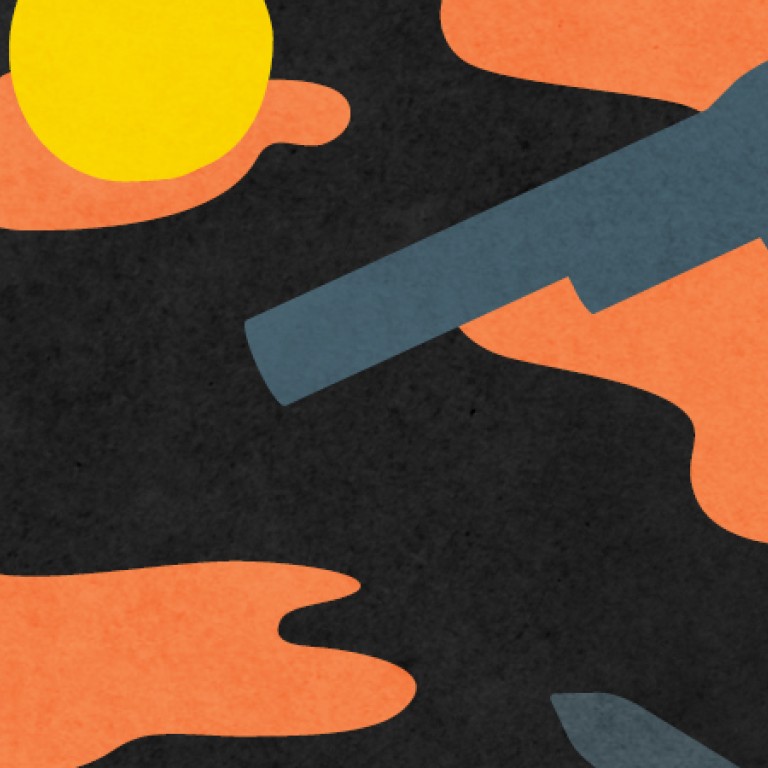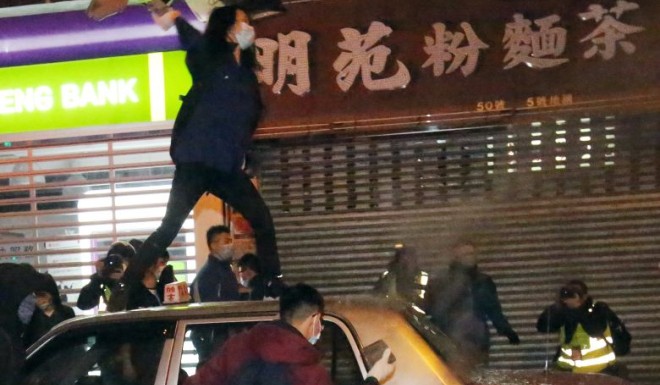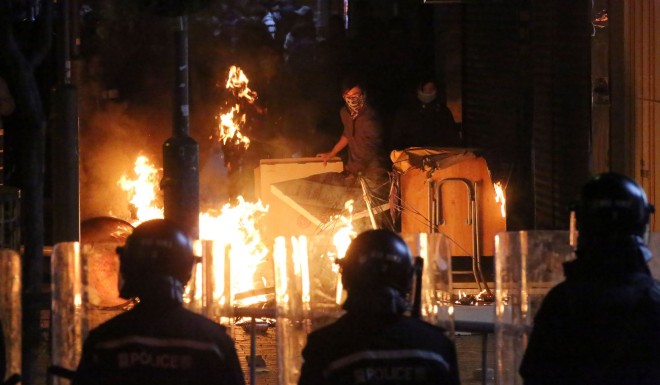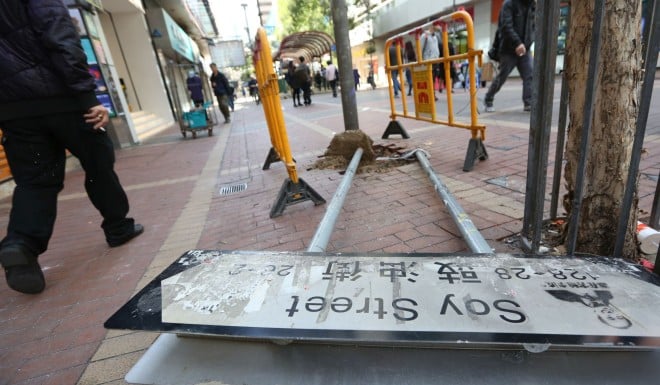
The Wake of Hong Kong's Fishball Revolution
The aftershock of a bloody clash reveals the city's deepening hatred of an overwhelmed police force.
On Monday, February 8, the first night of the Lunar New Year, Mong Kok was riled by a level of violence not seen since the riots of the 60s. The small police force stationed there, mostly traffic policemen, was outnumbered by a rioting crowd apparently incensed over the closure of holiday food stalls, a long-time city tradition.
Seemingly goaded on by localist group Hong Kong Indigenous, rioters set fires in the streets and flung bricks and garbage bins at police. Amid panic, the police reacted to protestors with batons to the head. One officer fired two shots in the air, an almost unheard-of response. Crowd control officers took more than four hours to arrive at the scene.
That night, around 130 public and police were admitted to hospitals, including an unarmed girl who was sent to an intensive care unit. But of the 130, 90 were police officers.
This week, 39 of the protesters in Mong Kok were charged, 15 of them students, in a packed Kowloon City courtroom. Why did it happen? And what’s the city’s tipping point?
Unusual Violence
Police monitoring organization Civil Rights Observer says Monday night was a powder keg: a small police force stationed in the area, swathes of young Hongkongers unhappy with the government, and what it sees as the authorities’ increasing tendency towards heavy-handed crowd control.
“I’m surprised that the police hadn’t prepared well for crowd management and they underestimated the behavior of protestors,” says Andrew Shum Wai-nam, a member of Civil Rights Observer.

That lack of preparation led to an unusually violent clash and “the police felt outnumbered,” Shum says.
One reporter from Chinese-language newspaper Ming Pao was beaten by police with batons even as he stated his identity—the violence was captured on video.
Government Responsibility
Since the outbreak of violence on the first day of Chinese New Year, there’s been little apparent action from the government to investigate what caused the conflict. Instead, there have been a string of condemnations.
New People’s Party leader Regina Ip Lau Suk-yee blamed the protests on the demonstrators’ social standing—underemployed and undereducated. Chief Secretary Carrie Lam Yuet-ngor and Financial Secretary John Tsang Chun-wah condemned Monday’s violence as inexcusable.
“The government never considers the social conflicts that may trigger this kind of event,” says Icarus Wong Ho-yin, also of the Civil Rights Observer. Wong’s colleague Shum agrees: “What we need to do is find out the reason behind the riot.”
Law Yuk-kai, the director of independent watchdog Hong Kong Human Rights Monitor, says that “the most important structural problem here is the deep hatred of the youth against police measures in the past, especially police brutality. The police got beat up for the first time—people are missing a very important part of this incident.”

Police Powers
Why draw and fire a gun, something never done even at the height of the Occupy protests?
Chapter 29 of the Police General Orders governs how a policeman uses force when dealing with a situation. Unlike most of the other Chapters, this section is closed to the public. But under a set of 1996 Police General Orders available to the public, the rules state that a police officer may draw or discharge a firearm “to quell a riot or insurrection… provided that no lesser degree of force can achieve his purpose.”
A police officer has to report every time he even draws a firearm. If he fires it, there’s a complex chain of reports and investigation. It’s a tedious process intended to make sure it doesn’t happen lightly.
A police investigation on Friday concluded that the officer who fired shots into the air had complied with the rules.
Baton Strikes and Oversights
But we as the public don’t get to see the investigation, and that’s a problem.
When the UN’s Committee Against Torture met in December 2015 to review the government’s implementation of the UN Convention Against Torture, the committee largely focused on how Hong Kong has failed to curb police powers and the unjust use of force—and on the gross failure of the system in place to provide public accountability for police actions. (The UN document is available to download here.)
In Hong Kong, the Complaints Against Police Office (CAPO) exists to record the public’s complaints against the police—just as its name implies. It’s overseen by a police watchdog called the Independent Police Complaints Council (IPCC). The UN committee expressed its dismay that the IPCC has “no power to conduct investigations on its own,” despite having authority over CAPO—and worse, the government does not report complete data regarding the outcomes of complaints.
The implications of this potentially toothless mechanism can be frightening for a protest like Monday’s—there’s little public oversight over an increasingly demoralized police force, who feel trapped between rioters and ill-prepared police brass.

“It’s very obvious that the police have used abusive force in handling protestors,” says Wong. “We’ve observed numbers of baton injuries to protesters’ heads increasing. Every attack on the head by a baton is lethal force. The function and the duty of the police is to restore order, not to kill civilians.”
Baton strikes to the head can indeed be lethal, and police forces around the world are taught to avoid them when possible. Again, the hidden Chapter 29 of the Police General Orders governs baton use in Hong Kong.
“The UN Committee Against Torture recommends Hong Kong police should disclose their guidelines on the general use of force, but there has not been a positive response yet,” says Wong.
With the incomplete data the UN was able to collect from the 79 days of Occupy regarding complaints against police abuse, it found that of 2,078 complaints lodged with CAPO, 104 were endorsed by the IPCC for investigation: a total of 5 percent.
Arms Race
Frontline officers are furious with management: They felt underprepared and underequipped on Monday night, and have come forward to say so. Junior police union chairman Joe Chan Cho-kwong appealed to lawmakers to back “new model weapons and gear,” such as water cannon.
And in fact, the Hong Kong Police has a tender closing on February 26 for three armored vehicles carrying water cannon that can blast some 200 pounds of force—a $27 million procurement approved by the Legislative Council last year.
Read More: Hong Kong's Tender for Armored Vehicles
But rights monitor Law says that that deploying vehicles with water cannon is futile—and will only escalate violence. The more the police force steps up their arms race, he says, from pepper spray to armored cars, the more violent protestors will grow.
“Police cannot expect to protect themselves with all these means at their disposal. It will only create more resentment and an escalation of force,” says Law. “The better the police gear, the more they put themselves in danger.”
Law says that “the only proper way to address protesters is for the police to use proportional means to target selected, specific persons. They should not target a whole group of people: Otherwise, it’s not law enforcement.”
And nor will the first fishball riot be the last.

